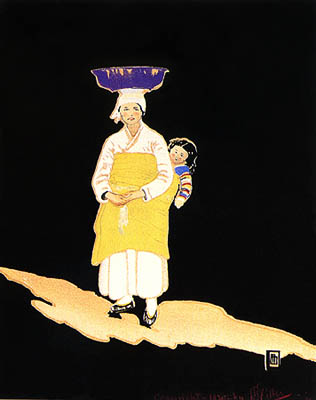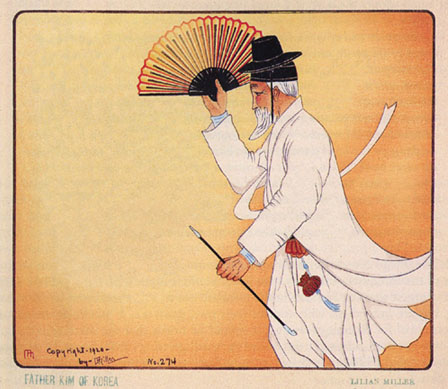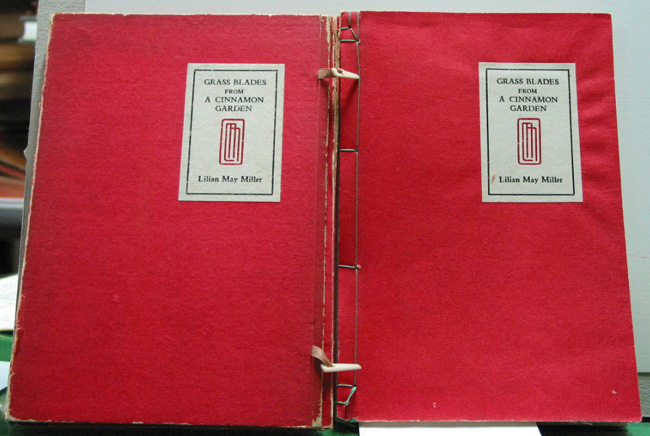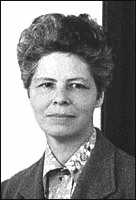Lilian May Miller (1895-1943)
The main source of information on Lilian Miller is Between Two Worlds: The Life and Art of Lilian May Miller,
by Kendall H. Brown, Pacific Asia Museum, Pasadena, CA: 1999. What
follows is based on that, and on other sources of information.
Lilian Miller’s father, Ransford Stevens Miller Jr. (1867-1932) was
born in Ithaca, New York on October 3, 1867. He entered Ithaca High
School from Ithaca Grammar School in September, 1880, graduated in
1884, and entered Cornell University the same year. He graduated A.B.
in 1888. He went to Japan in about 1890 to serve as secretary to the
International Committee of the YMCA in Tokyo. He quickly mastered
Japanese and from 1895 was acting as interpreter to US Legation, Tokyo.
In 1894 he married Lilly Murray of Lockport, N.Y., who had arrived in
Japan as a missionary in 1888. They had two children—Lillian May was
born on July 20, 1895 and Harriet Hartmann on October 2, 1897. By 1898
he was acting as “Japanese secretary” in the American Legation in
Tokyo, having become part of the diplomatic corps by an indirect route.
He served for a time as a member of the Council of the Asiatic Society
of Japan. In 1909 he was called to Washington to become chief of the
Division of Far Eastern Affairs at the State Department.
Lilian began studying traditional Japanese painting
under Kano Tomonobu in 1904, when she was only nine, then in 1907 she
transferred to study under the younger Shimada Bokusen and exhibited
her first work that year. Then, living for the first time in her life
outside of Japan, she graduated from Western High School in Washington,
DC and went to study at Vassar College in New York, where she was a
classmate of the famous poet Edna St. Vincent Millay, graduating in
1917. By that time her father had been serving as American Consul
General in Seoul since 1914, a position he held again after a brief
interruption 1920 - 29. Lilian spent about a year with her parents in
Korea after graduating, then went to work in September 1918 as a
secretary in the Division of Political Affairs at the State Department.
In October 1919 she quit and returned alone
to Japan and to studies with Shimada Bokusen. A painting “In a Korean
Palace Garden” based on a sketch she had made in Korea earned her a
high award at the 1920 Imperial Salon. It was in September 1920 that
she turned to woodblock print production, in part because she needed a
way of earning a living. By 1922, she is said to have produced more
than 6,000 prints and holiday cards, and had figured in a number of
newspaper articles in Japan and the US. Kendall H. Brown stresses the
skill with which she devised a way of self-construction stressing her
dual identity as a modern, liberated, American girl and an oriental
artist entirely devoted to her craft, learned during years of arduous
study under reputed masters.
Lilian’s first prints were very largely based on
drawings made in Korea and she went so far as to declare to the San Francisco Examiner
that her mission in life was “to portray the hidden beauty of the
Hermit Kingdom.” Yet Brown argues strongly that in fact her
representations of Korea are weak, Orientalist, stressing the "quaint"
aspects that confirm Japanese representations of Korea as a backward
country whose only hope for development is to become fully part of
Japan. [See a slideshow of her Korean prints] Certainly there is a vast difference between her pictures and
those of Elizabeth Keith who was painting Korean scenes at the same
period in a very different spirit.


On September 1923 Tokyo was largely destroyed by the
great Kanto Earthquake; Lilian was in Seoul on a visit to her parents at the time,
she was safe, but her studio, with her woodblocks, as well as the
printer’s shop where her book of poems Grass Blades was being
printed, were all destroyed. She then fell seriously ill,
perhaps with beriberi, a vitamin-deficiency disease, and she spent
three years recuperating in her parents’ home in Seoul. In 1927 she was
well enough to publish a revised version of her poetry book Grass Blades from a Cinnamon Garden
and start producing new prints, including re-issues of earlier ones.

Kendall H. Brown stresses the visual quality of many of the poems, and
concludes that while “her poetry was often flat and contrived, her art
was becoming increasingly radiant and natural.” A number of the poems
in the volume are ardent expressions of love addressed, it seems, to
women and Brown notes: “The feminized Orient, alternately maternal and
sexual, is easily linked to the desired lover who is at once the gentle
teacher and the object of amorous desire. Thus, the Orient becomes the
lover and the lover becomes the Orient, both ideal states of grace and
sites of feminine creativity.” (p.25)
 Lilian with a Japanese companion. Photo from Faith Norris's Book
Lilian with a Japanese companion. Photo from Faith Norris's Book
As Lilian prepared to make a visit to the United
States late in 1929 to renew contacts with the American art world, she
happened to meet Grace Nicholson (1877 – 1948), who dealt in oriental
antiquities, in Seoul, and this friendship enabled Miller to meet and
make use of many important art contacts on her American trip and
afterwards. During her lectures and exhibitions in America, she dressed
in Japanese style, wearing an elaborate kimono. In 1930, her father
returned to the US and became head of the Far Eastern Department in the
State Department, Washington. Still active in 1931, he died in
Washington in 1932 and another funeral was held in Tokyo in October
1932 when his wife and Lilian took his ashes to be interred in Yokohama
Foreign Cemetery. After that her mother stayed with her in Japan.
During the Depression, Lilian evolved a new style of watercolor that
sold well.
In 1935, she had surgery for a large cancerous tumor, including a
hysterectomy. For a long time, Lilian had been ardently pro-Japanese,
regarding the growing involvement in Manchuria and China. However, in
early 1936, after Japanese radical officers assassinated several
leading politicians, Lilian and her mother left Japan and moved to
Honolulu. There she returned to watercolors, usually working outdoors.
Another relocation in late 1938 to San Francisco may been due to the
larger access it offered to commercial markets. The massive redwoods
and cedars of California reminded her of growing up in Nikko, and she
began to include them in her work.
 Undated photo
Undated photo
In the summer of 1941 she and a friend made an adventurous 3-week
hiking trip through southwest Alaska. The Japanese attack on Pearl
Harbor in December was a terrible shock to her, she felt betrayed by
the country of her birth and adoption. She signed on with a Naval
counter propaganda branch as a Japanese Censor and Research Analyst.
Late in 1942, she was found to be terminally ill with cancer and she
died on January 11, 1943.
 Waterfall: Lilian May Miller
Waterfall: Lilian May Miller





 Undated photo
Undated photo